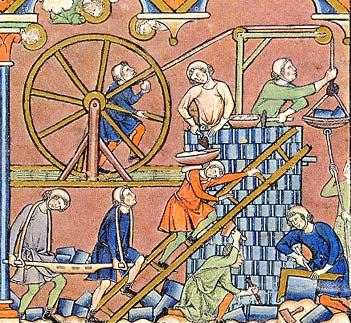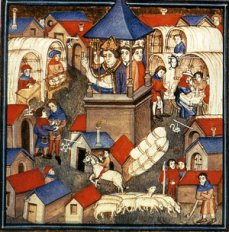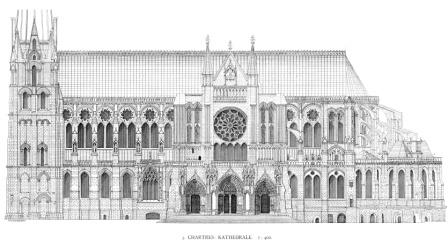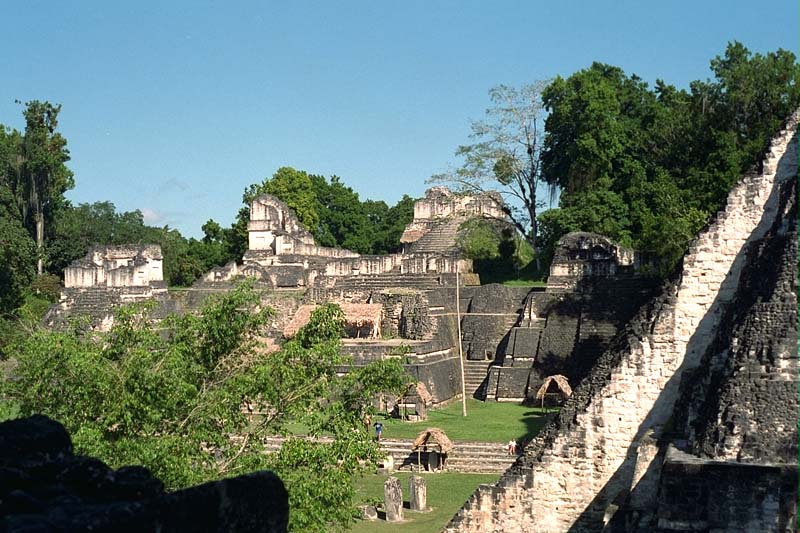Central Middle Ages
Central Middle Ages (1050 to 1300)
In the history of project management this period was known as the Early Gothic Era and brought to an end the dark ages in Europe, a period of stifled growth, through the urbanization of Europe, military expansion (Crusades), and intellectual revival.
Rediscovery of Lost Ancient KnowledgeChina was undoubtedly the most technically advanced region in the world, particularly with regard to the use of coke in iron smelting, canal transport and farm implements. Bridge design and textile machinery had also been developing rapidly[1]. From a project management perspective in Europe there was a rediscovery of lost ancient knowledge that inspired a period of learning and growth, setting up of universities. It also provided a new confidence for the masterbuilders when examining the past, for example the architectural achievements of ancient Rome. The period was dominated by construction projects for the Gothic Cathedrals driven by the Christian church, and the town itself. There was also a major boom in castle building that extended through the period. |
 |
Cathedral of Chartres, France 1194 to 1260Through a period of several hundred years cities in Western Europe strived to out do each other in creating the ultimate cathedral in splendor and height. In these years more stone was excavated than at any time in Ancient Egypt[i]. The cathedral boom was spurred by the competition for pilgrims between cities. The cathedrals had a major impact on the prosperity and importance of the city as they attracted thousands of pilgrims. The merchants in a city recognized the value a cathedral could bring. In this period world record fever gripped the cities as they poured in resources to build their own cathedral. It was broken 5 times within 62 years. The Cathedral projects took generations to complete (some over a hundred years, very few were completely finished), and therefore required long-range planning as the output had to be built with painstaking precision and incredibly complex detail. Cutting corners carried great project risk and could lead to calamitous consequences, in lives and having to redo years of work. A cautious and safe approach to the project was required daily. A project governance structure was required to find the funding for the project. By today's estimates the Chartre cathedral project cost around $1 billion, and absolute fortune for a town of 10,000 people. The project was subject to a constant cycle of stops and starts as funding ran out. |
 |
A Project Governance StructureThis was also paramount to keep the project going over the times spans, as was how the project was run by a master builder (there was an expectation that no one single master builder could finish the project off). For example, Chartres Cathedral had nine master builders. Each time a master builder took over they would use different standards of measurement, and therefore had to continually adjust calculations, based on what was done before. The cathedrals were a showcase for the church, reaffirming its power and authority. The towering walls of stained glass windows poured colored light in, an amazing spectacle in the medieval world. These windows narrated stories and transmitted information to all inside. Chartres had over 32,292 sq ft (3000 sq ms) of stained glass.The end results at Chartre were stunning. The spire at Strasbourg Cathedral reached 142 meters (almost 500 feet), and the 48 metre (150 feet) nave at Beauvais Cathedral could hold a fourteen floor building. When a Gothic Cathedral was completed it was by far the largest indoor space in the town. The buildings were vast caverns of space, through pointed arches and vaulting for a high roof. |
 |
Function of CathedralsAt Amiens the cathedral floor space of 7,700 meters could hold the entire population of the city some 10,000 people. The buildings were used for numerous purposes not just religious, for example, public or civic meetings, magistrates or heads of guilds meetings, or fairs with stalls. The Gothic Cathedral allowed men from all social classes to meet, from kings, noblemen, to peasants. |
 |
Mayan Temples at TikalOver time the projects evolved so human capital was augmented by the power of large beasts and early machines. The Mayan Temples at Tikal were built without the use of the cartwheel or metal tools. The Maya developed their own mathematics, using a base number of twenty, and even had a concept of zero. The site consists of 6 temples the tallest reaching 64 m (208 ft). |
 |
Angkor Wat in Cambodia, 1113-1150This is a temple within a moat and an outer wall 3.6 km (2.2 mi) long. Within are three rectangular galleries, each raised above the next. At the centre of the temple stands a quincunx of towers, the central rises to a height of 65 m (213 ft) above the ground, surrounded by four more. These evolved from the single brick tower and took nearly 30 years to build. Sandstone blocks were carefully to fitted together, but vertical joints made the walls very unstable as no mortar was used, just a good fit, weight and gravity which was thought sufficient. But one dislodged stone near the base could bring the wall down. |
 |
[1] Source: Technology in World Civilization, P7, Arnold Pacey.
[i] Source: The Cathedral Builders by Jean Gimpel, p1
